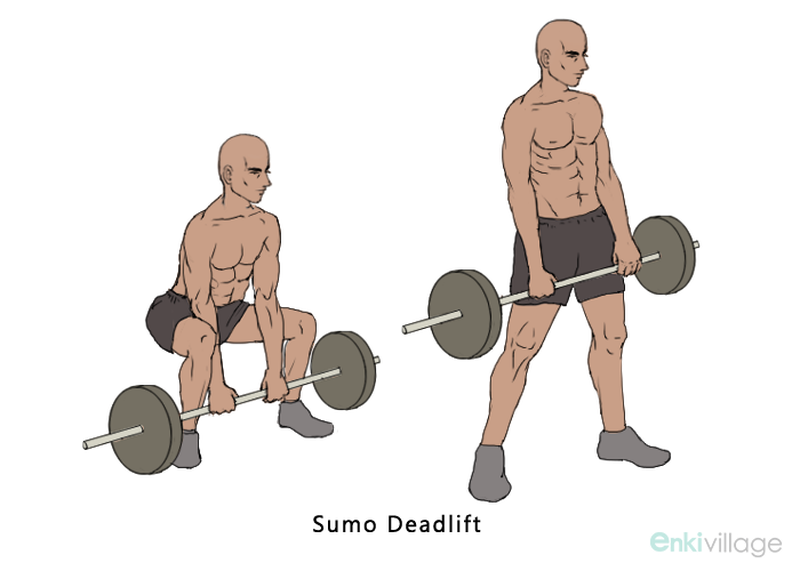One of the biggest means of building up testosterone and consequently muscles is to bend over and hoist a weight off the ground. Aside from building up muscle in almost every part of the body, it can help you in building core strength and grip too which are among the two great advantages for all lifters. The deadlift focuses on hip extension, making it an ideal exercise for building lower body strength for performing athletic endeavors and for developing glutes and hamstrings.
Although it might seem simple to bend over and hoist a weight off the ground, technique and form can be different for each lifter depending on factors like flexibility, height and limb length. The traditional deadlift and sumo deadlift are two main variations and each places different demands on the body than the other.
What Is Sumo Deadlift?
A wide-stance deadlift in which your hands are on the inside of your thighs is referred to as the sumo deadlift. Because of the wide stance, it is also known as the Wide Stance Deadlift. The primary muscle worked are the hamstrings.
Other muscles worked inlcude: quadriceps, glutes, adductors, traps, middle and lower back and forearms.
Top Benefits of the Sumo Deadlift:
1. It minimizes the range of motion of the pull
2. It focuses on your hips
3. It applies less stress on the lower back
Difference Between Sumo Deadlift and Conventional Deadlift
Stance
The conventional and sumo deadlift both focus on the back but the conventional deadlift requires the lifter to assume a bent over posture since he has to place the feet close together exposing him to lower back aches. The sumo deadlift on the other hand requires the lifter to assume a wide-stance, allowing him to keep his torso taller while bringing him closer to the ground. However, the sumo deadlift can place unwanted stress on the knee as it demands a great deal of hip flexibility.
Power and Weight Lifted
Sumo vs. conventional deadlift comparison shows that lifters using conventional stance can generate more power and lift heavier weights off the floor than those using the sumo stance.
It is usually observed that lifters having longer torsos and shorter legs work best with sumo while those with shorter torsos and longer legs prefer conventional. However, when it comes to sumo deadlift vs. conventional, lifters must experiment with both to determine which one is more suitable for them.
How to Practice Sumo Deadlift
Start with the bar laid out on the floor. Stand in front of the bar in such a way that it intersects the middle of the feet. Keep the feet wide and then grip the bar by bending at the hips. You can use a hook grip, a pronated grip or a mixed grip. Keep the arms directly below the shoulder and inside the legs. Lengthen your arms by relaxing your shoulders.
Lower your hips after taking a breath with your chest up and looking forwards with your head. Transferring the weight on the back half of the feet, drive through the ground, spreading your feet apart. Now extend your body using the knees and hips.
As the bar reaches the knees, pull your shoulder blades together and drive your hips into the bar while leaning back.
Place the weight back onto the floor by bending at the hips and keeping the weight steady on the way down.
Video: 5 Steps to a Perfect Sumo Deadlift:
Tips for Practicing Sumo Deadlift
Warm Up
Adopt a half kneeling position, keeping your right foot out in front and the left knee on the ground to stretch your hip flexors. Lean your upper body back and push your hips forward. Remain in this position for 15 seconds and then switch sides. Stand in a doorway and place your forearms on either side for stretching your chest. Lean forward until you feel a stretch through your shoulders and chest.
The Intensity and Combination of the Two
Irrespective of whether you are trying conventional or sumo style, picking weights off the ground must remain an essential part of your program. Deadlift can help in strengthening the lower body as well as improving posture by working the muscles along the upper back. Although both variations are equally essential, lifters might find one variation more comfortable for them for heavy lifting than the other. In such cases, the other variation must be used for accessory lifting to enhance the strengthening of the hip extension motion. It is better to start with the conventional deadlift in the beginning and as you develop the hip flexibility required for sumo style to move on to the sumo deadlift.
Toes Should Point Outwards
It is important to not keep your feet straight as it would take the bar further away from you. Turn your toes slightly out so that you can place the bar on your inner shins, allowing you to place the bar closer to you making your pull shorter.
Get Your Hips as Close to the Bar as Possible
Get the hips low enough that your back remains straight and still a good tension remains in your hamstring.
Get the Body Behind the Bar
The more body weight you put in front of the bar the harder it will be for you lock out. However, your head and chest must remain behind the bar to finish the lift easily. A good way of putting the body weight behind the bar is to pull down on the bar before lifting it and then pulling the bar into the body.
Be Careful
Keep the sumo stance moderate and don’t go too wide or it would become difficult for you to get the bar moving as the sumo deadlift is easier to lock out and harder to move off the floor.




View All Comments /Add Comment